Combined Effects of Heat and Drought Stress on the Growth Process and Yield of Maize (Zea mays L.) in Liaoning Province, China
Abstract
:1. Introduction
2. Materials and Methods
2.1. Materials
2.2. Methods
2.2.1. Drought Identification Method
2.2.2. Method for Identifying Heat Events
2.2.3. Identification of CHD Events
2.2.4. Simulation of Meteorological Yield and Yield Reduction in Maize
2.2.5. Average Multi-Year Growth Date of Maize
2.2.6. Correlation Analysis and T-Test Analysis
3. Results
3.1. Temporal and Spatial Characteristics of Combined CHD Events in Summer over 60 Years
3.1.1. Annual Variation Characteristics
3.1.2. Spatial Distribution Characteristics
3.2. Effects of Summer CHD Events on Maize Photosynthesis and Yield
3.2.1. Effects of CHD Events on Maize Yield
3.2.2. Effects of CHD Events on Maize Photosynthesis
3.3. Effects of CHD Events in Typical Years on the Growth Process of Maize
3.3.1. Effects of CHD Event on Maize Growth in 2009
3.3.2. Impact of CHD Event on Maize Growth in 2018
4. Discussion
4.1. Identification of CHD Events of Maize in Liaoning Province
4.2. Sensitivity of Maize Growth and Development to CHD
5. Conclusions
5.1. Temporal and Spatial Characteristics and Development Trend of Maize CHD in Liaoning Province
5.2. Effects of CHD on Maize Growth and Yield in Liaoning Province
Author Contributions
Funding
Institutional Review Board Statement
Informed Consent Statement
Data Availability Statement
Conflicts of Interest
Appendix A
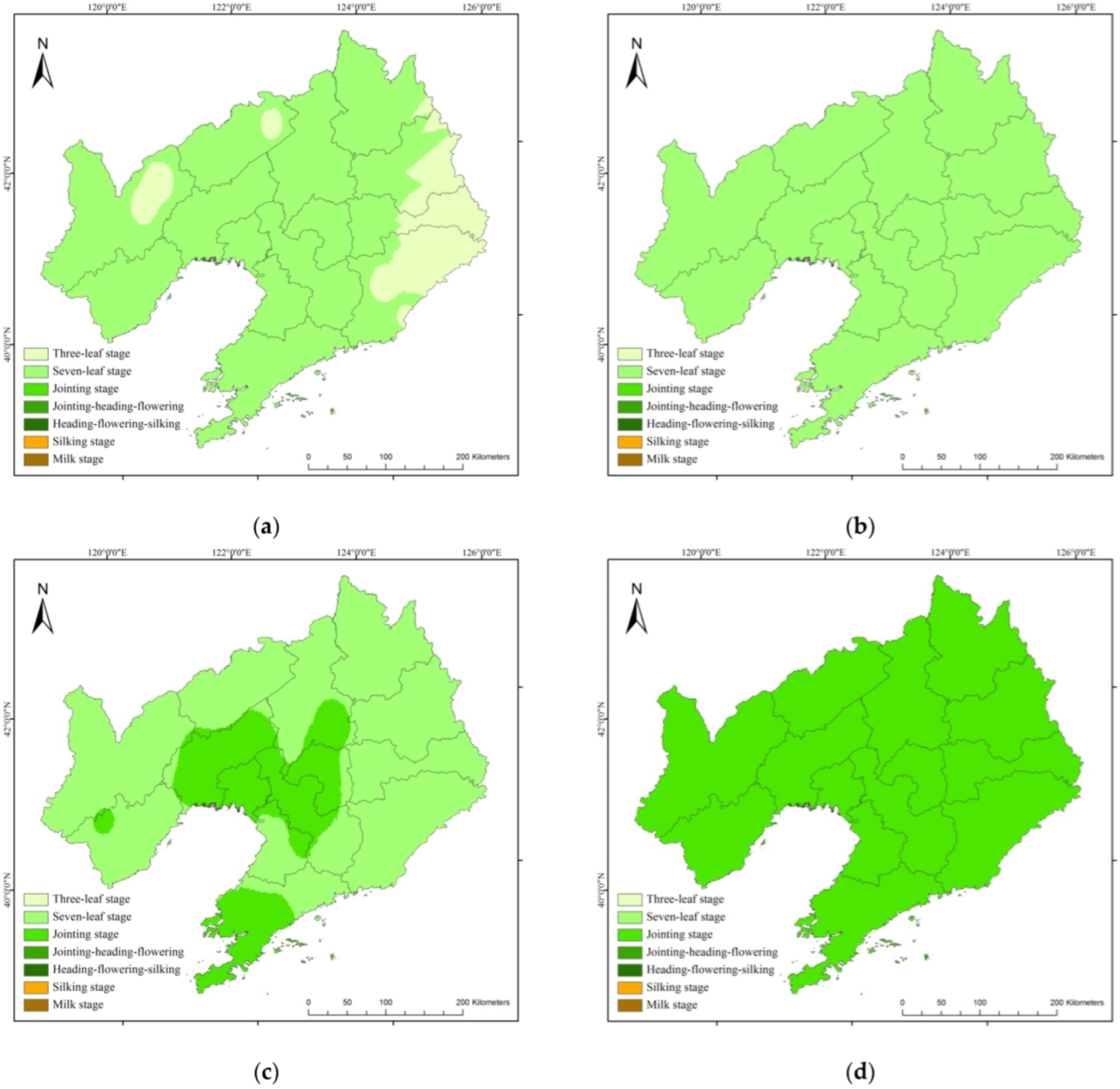
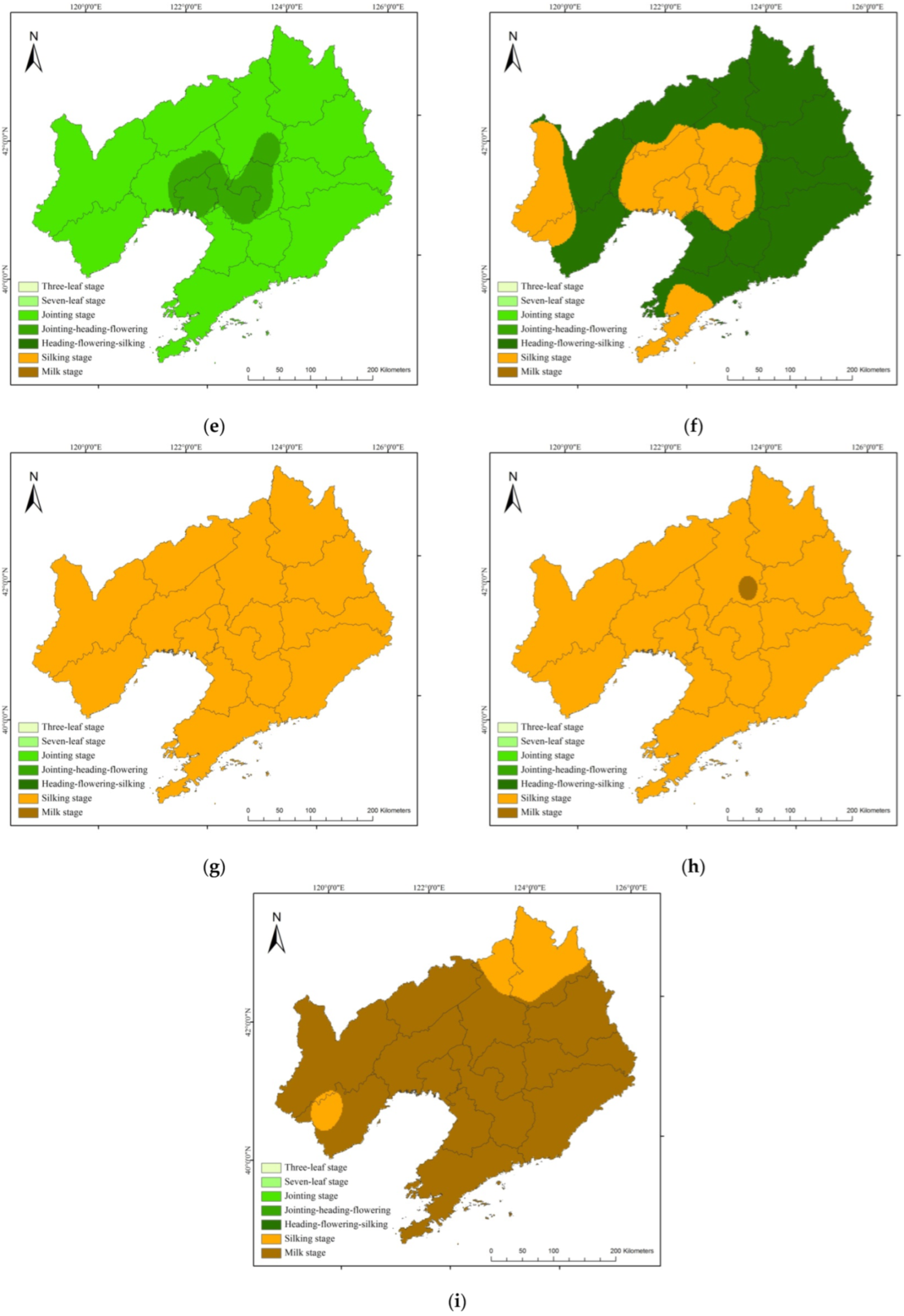
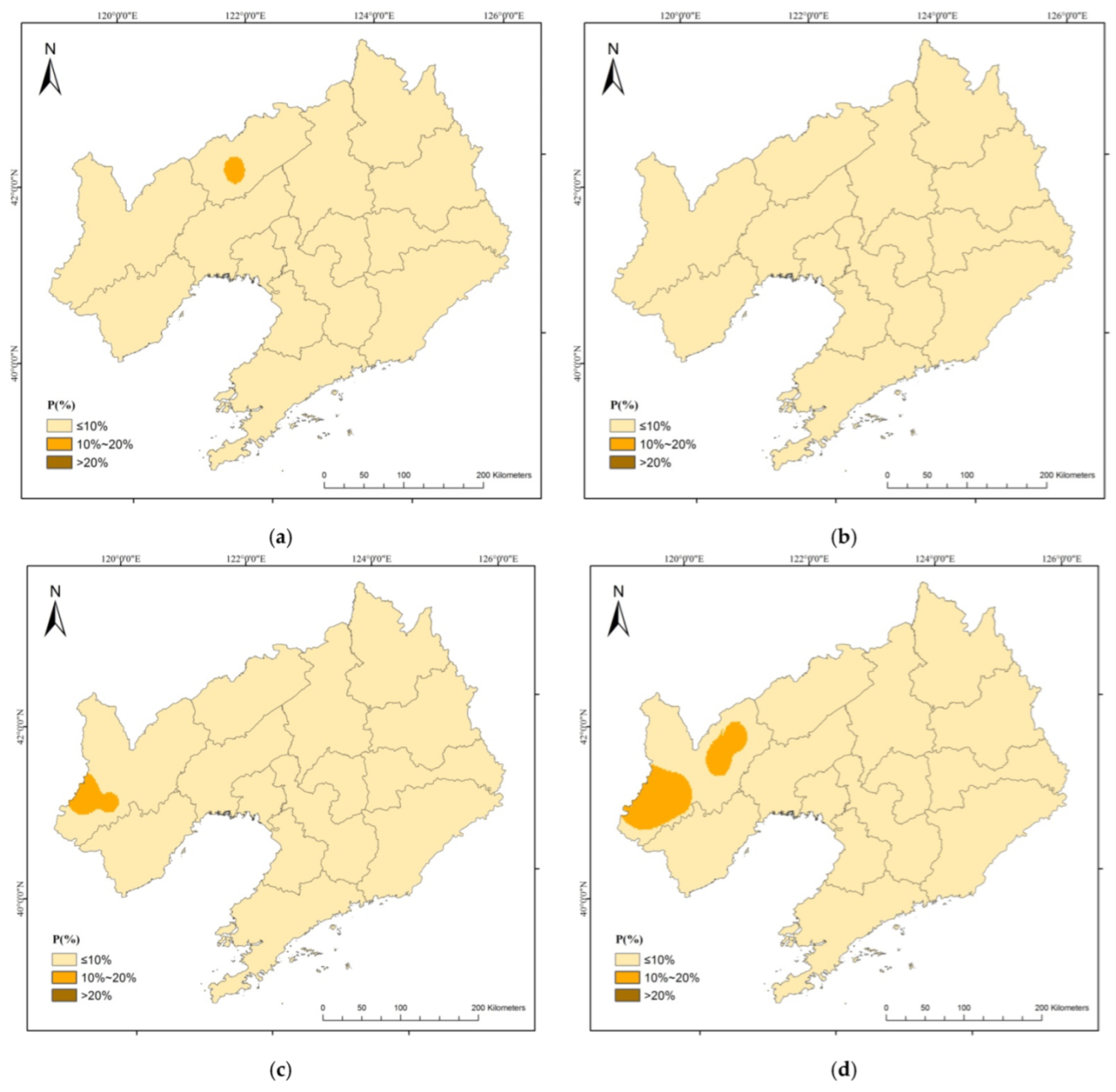
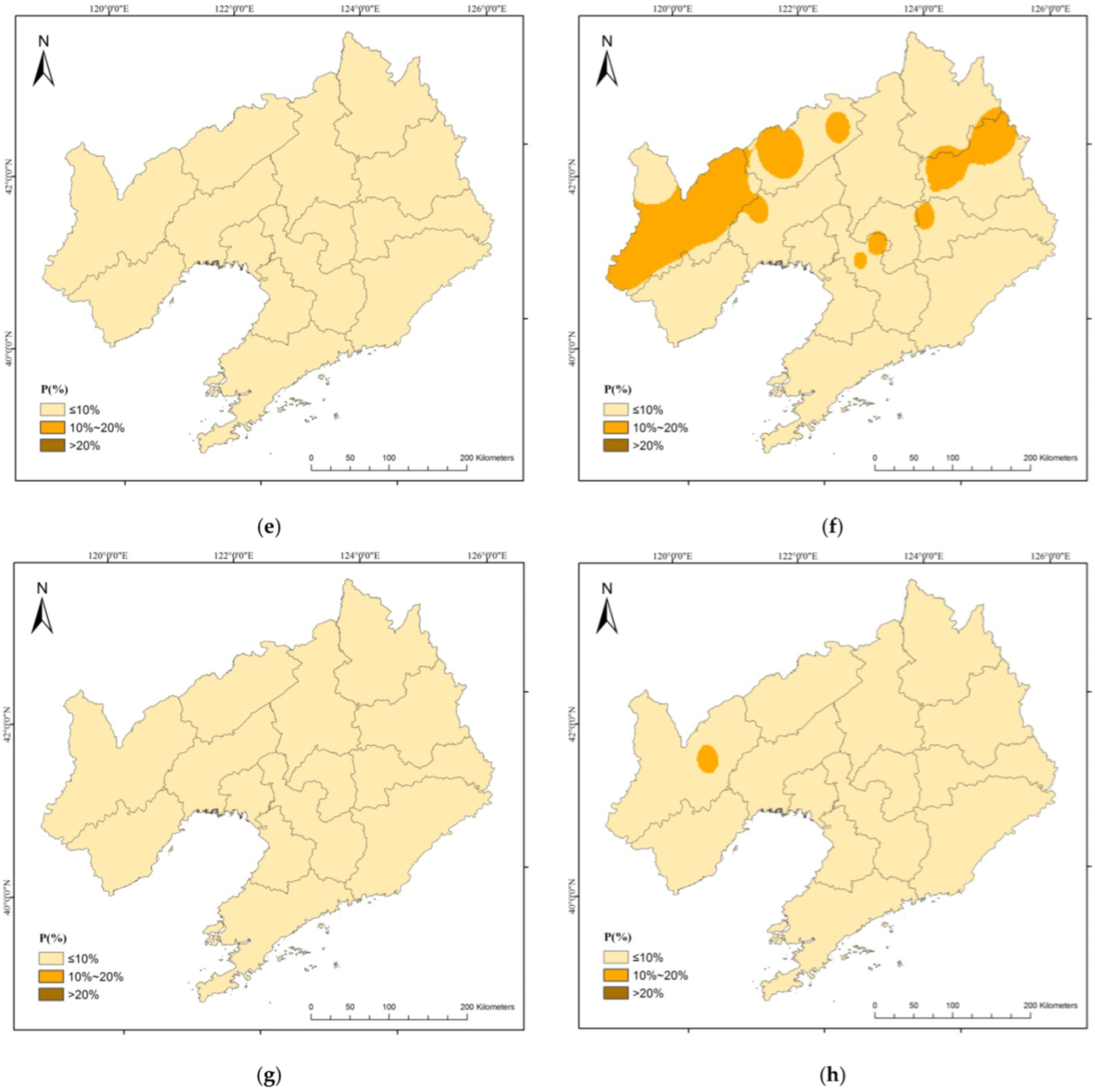
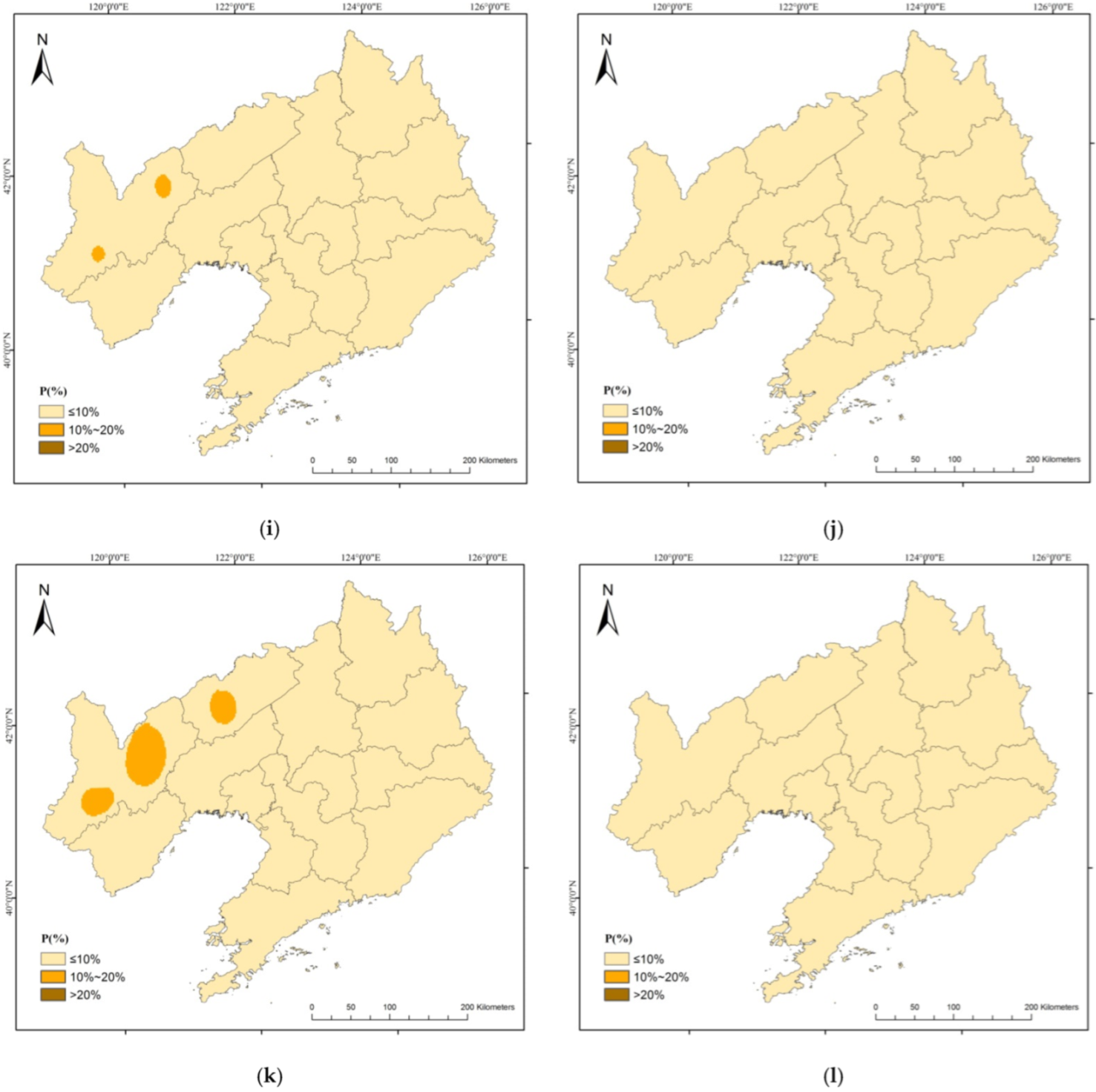
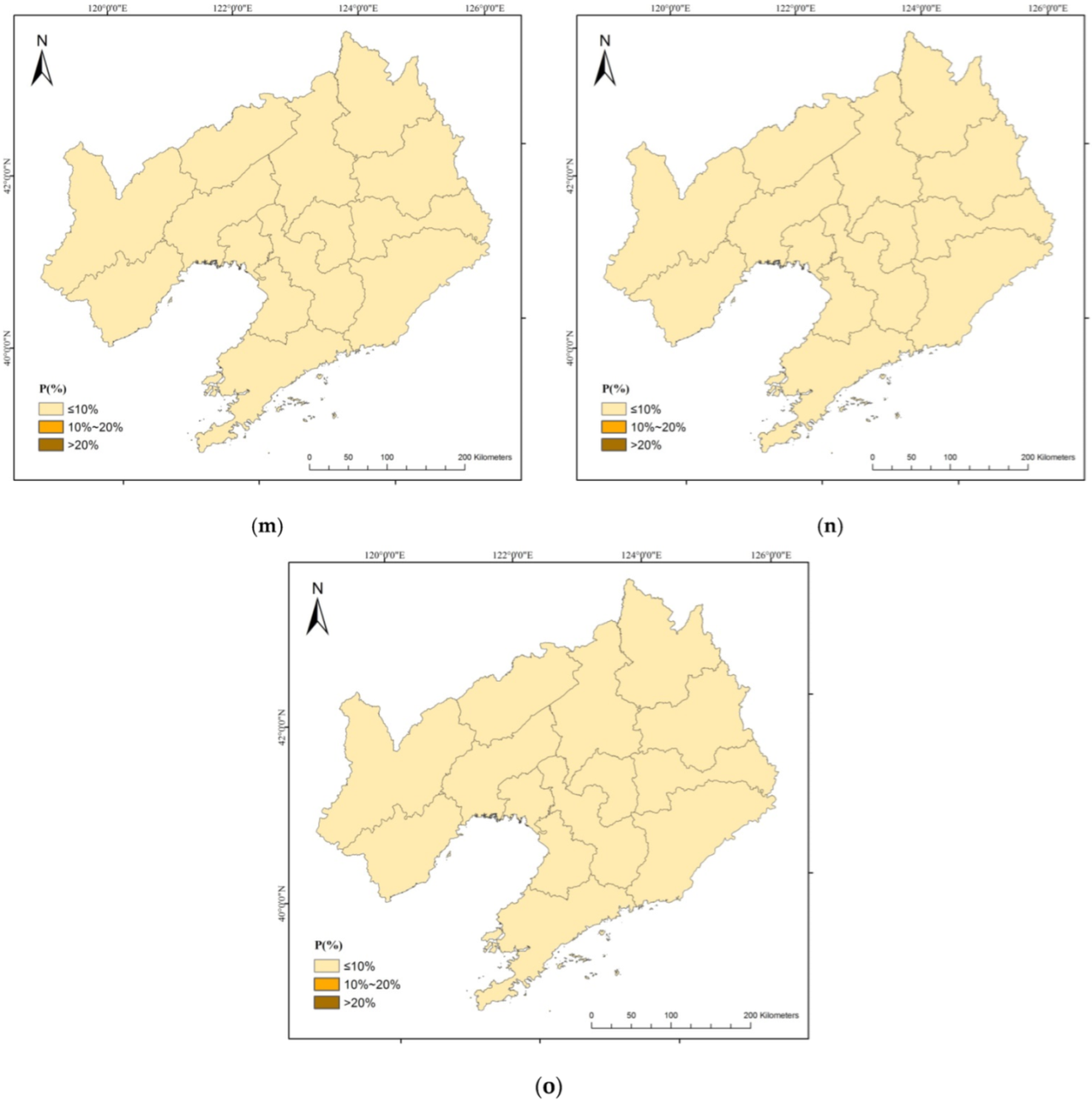
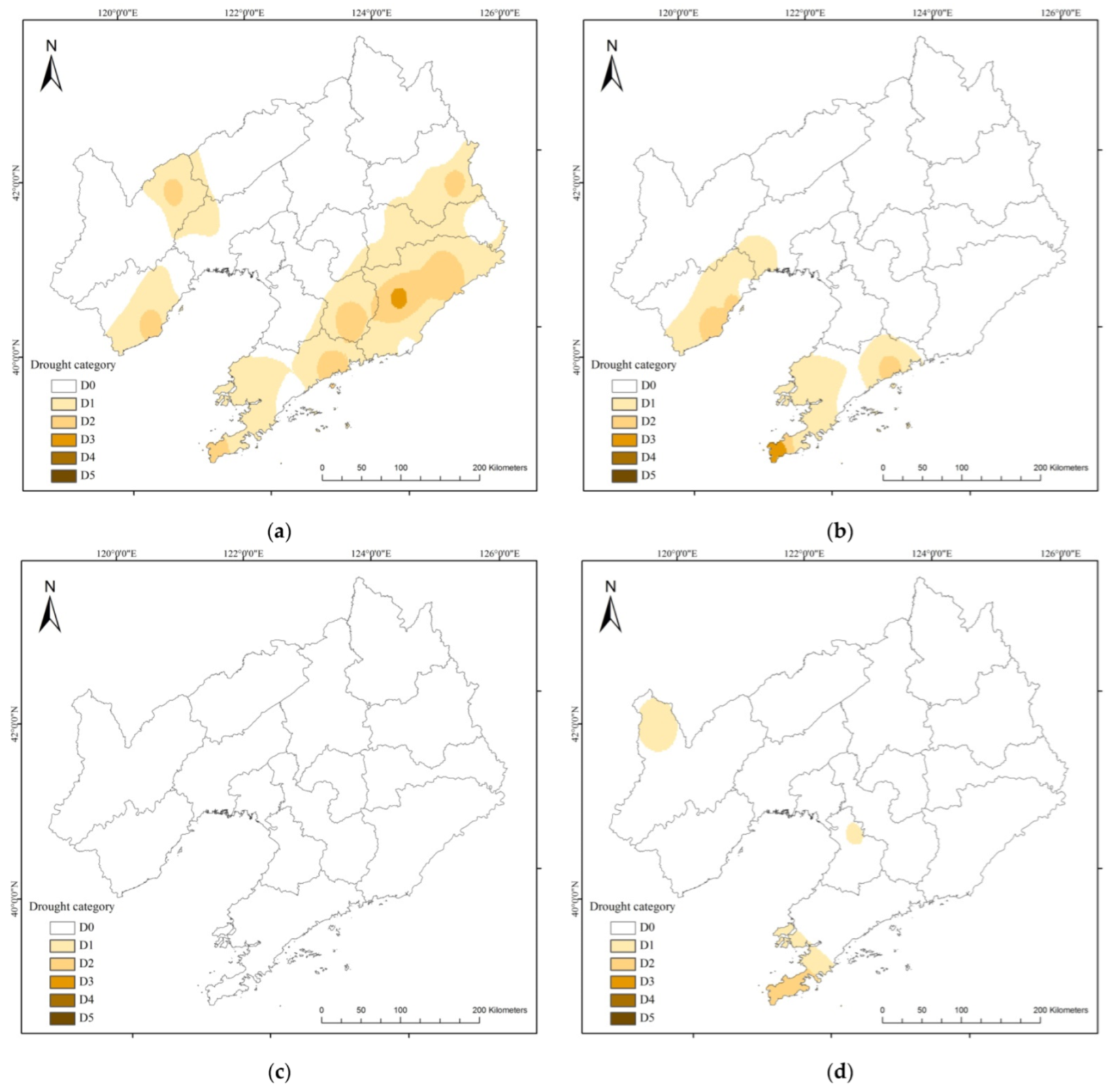

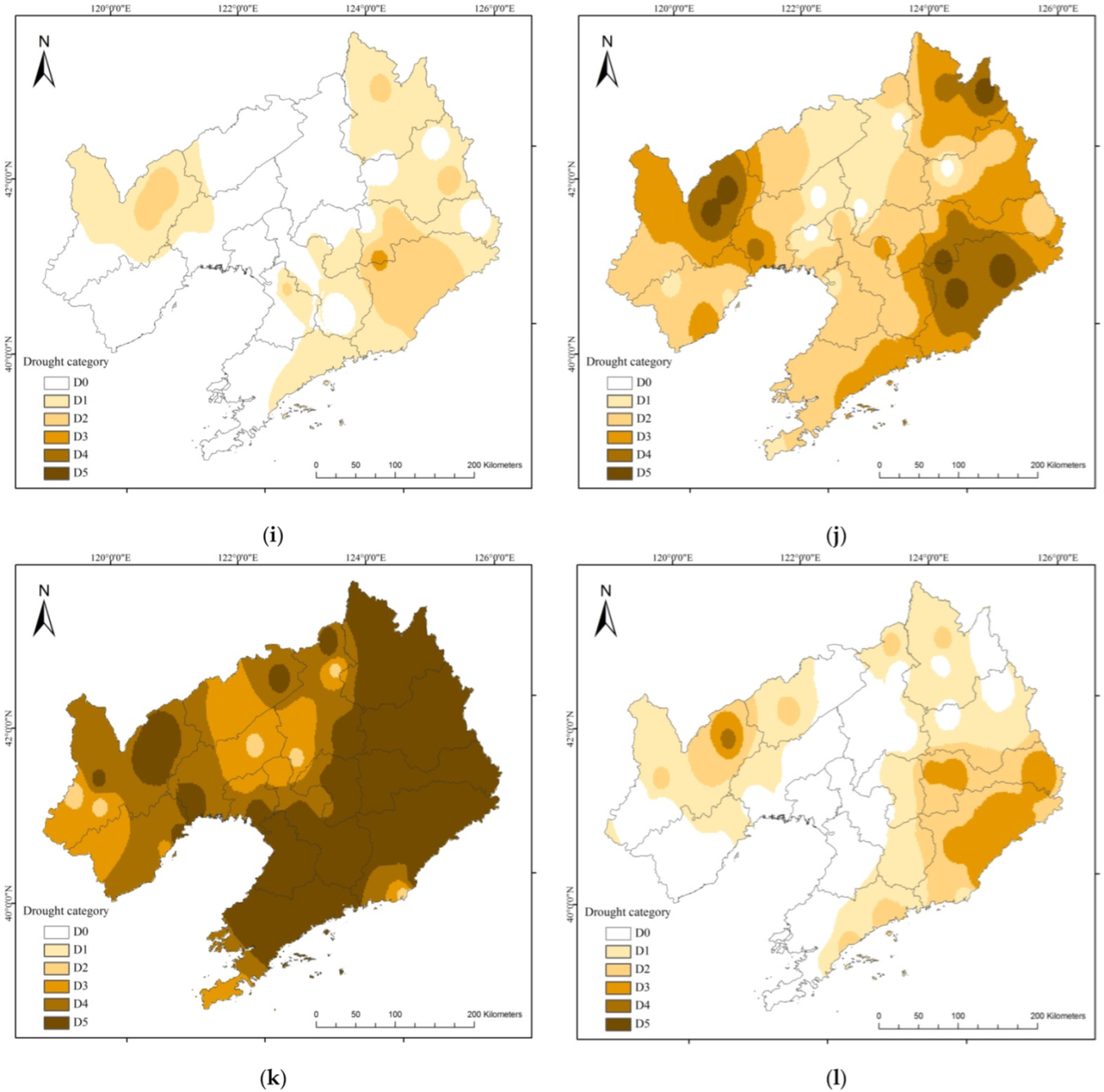



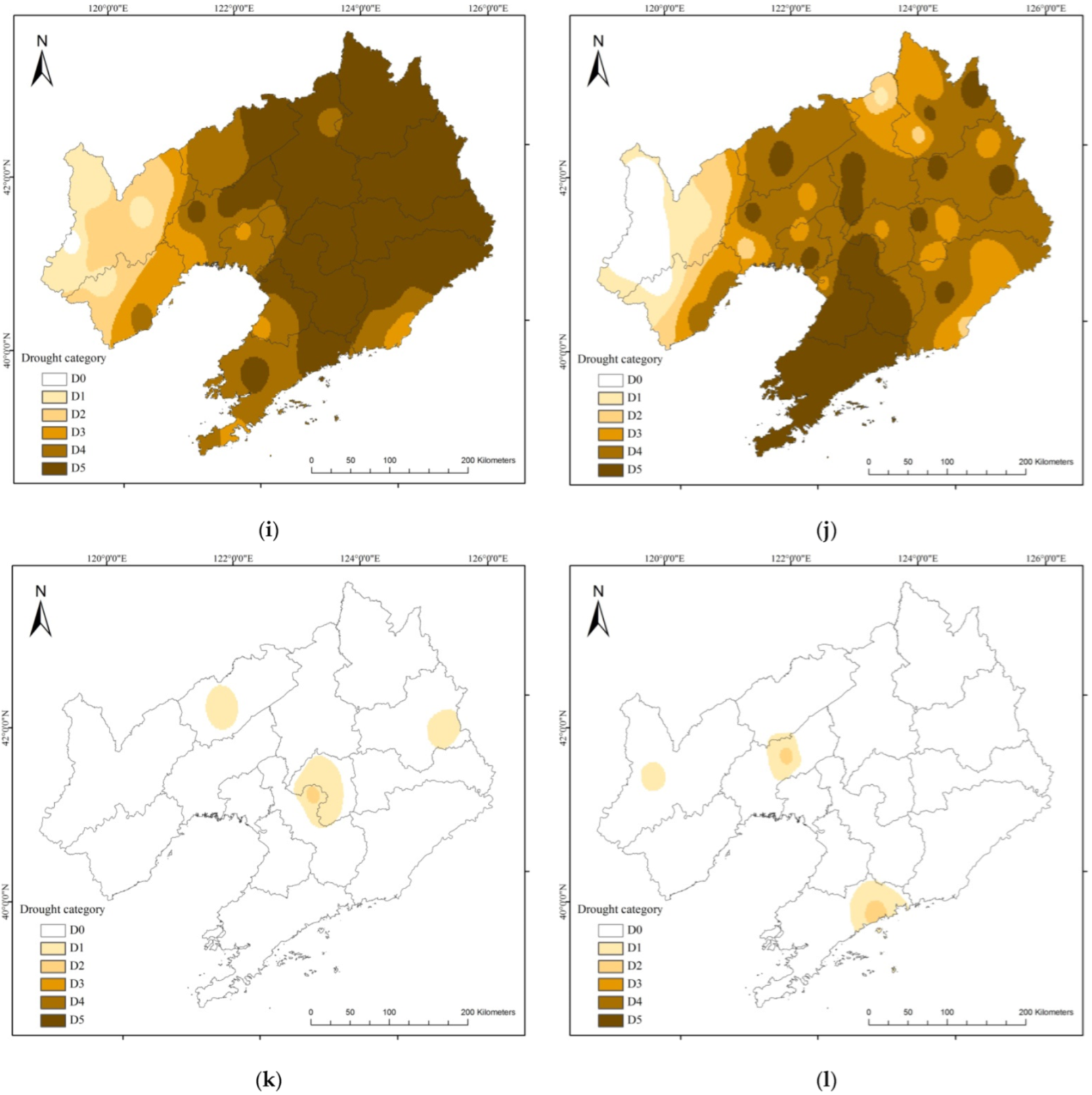
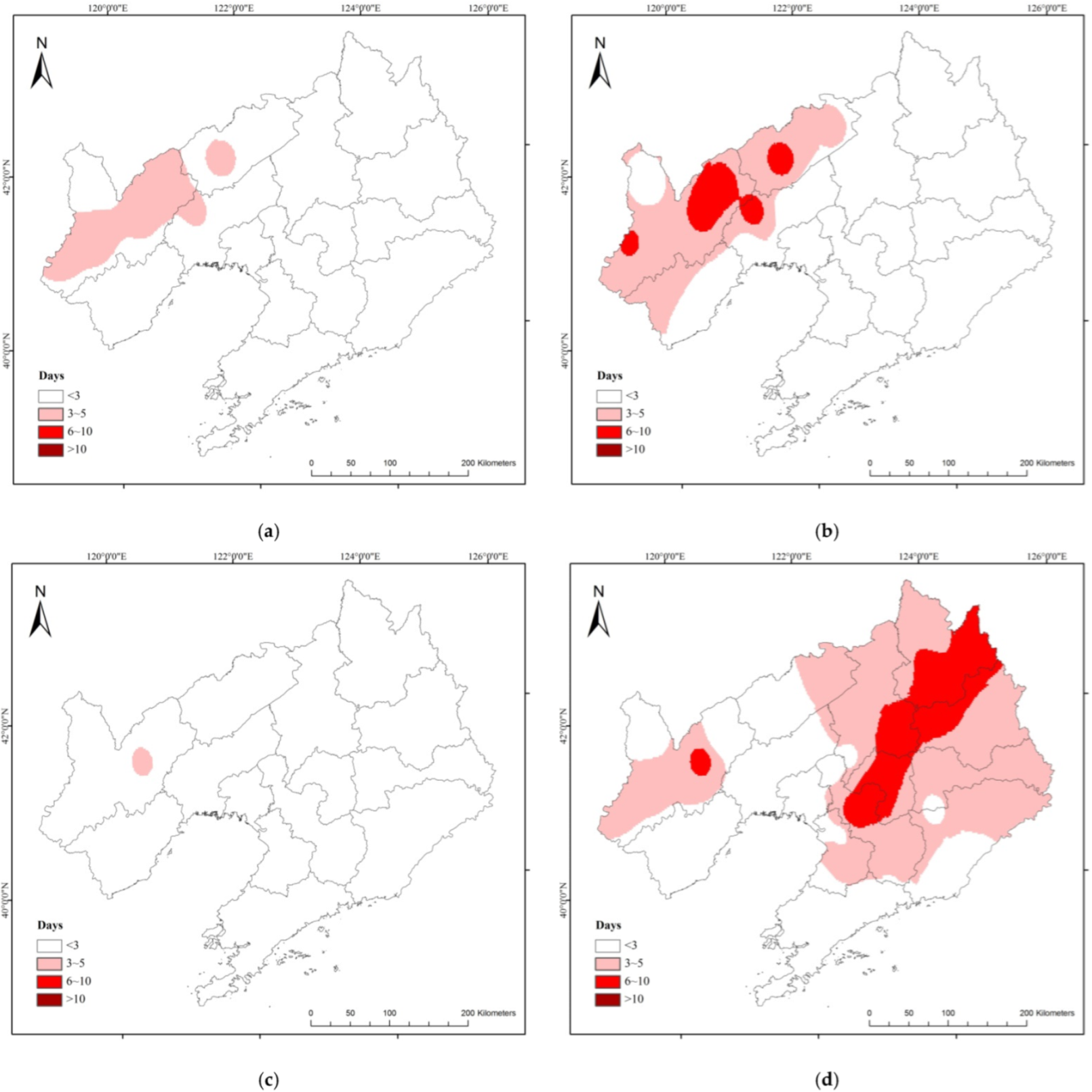
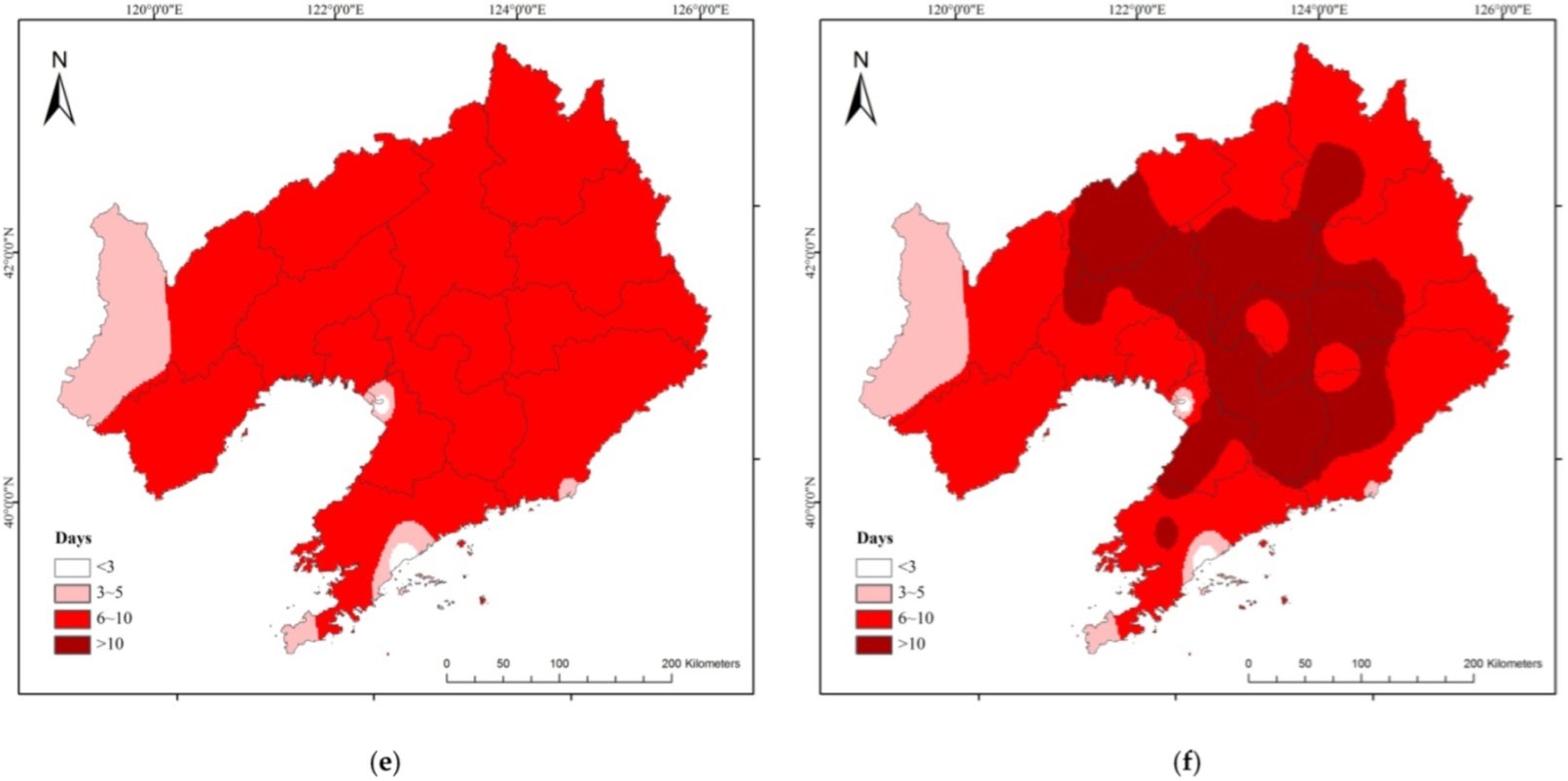
References
- Ceglar, A.; Toreti, A. Seasonal climate forecast can inform the European agricultural sector well in advance of harvesting. npj Clim. Atmos. Sci. 2021, 4, 42. [Google Scholar] [CrossRef]
- Ciais, P.; Reichstein, M.; Viovy, N.; Granier, A.; Ogee, J.; Allard, V.; Aubinet, M.; Buchmann, N.; Bernhofer, C.; Carrara, A.; et al. Europe-wide reduction in primary productivity caused by the heat and drought in 2003. Nature 2005, 437, 529–533. [Google Scholar] [CrossRef] [PubMed]
- Lesk, C.; Anderson, W.; Rigden, A.; Coast, O.; Jägermeyr, J.; McDermid, S.; Davis, K.F.; Konar, M. Compound heat and moisture extreme impacts on global crop yields under climate change. Nat. Rev. Earth Environ. 2022, 3, 872–889. [Google Scholar] [CrossRef]
- Hussain, H.A.; Saddam, H.; Abdul, K.; Umair, A.; Anjum, S.A.; Shengnan, M.; Longchang, W. Chilling and drought stresses in crop plants: Implications, cross talk, and potential management opportunities. Front. Plant Sci. 2018, 9, 393–414. [Google Scholar] [CrossRef] [PubMed]
- Ostmeyer, T.; Parker, N.; Jaenisch, B.; Alkotami, L.; Bustamante, C.; Jagadish, K.S. Impacts of heat, drought, and their interaction with nutrients on physiology, grain yield, and quality in field crops. Plant Physiol. Rep. 2020, 25, 549–568. [Google Scholar] [CrossRef]
- Li, Y.; Guan, K.; Peng, B.; Franz, T.E.; Wardlow, B.; Pan, M. Quantifying irrigation cooling benefits to maize yield in the US Midwest. Glob. Change Biol. 2020, 26, 3065–3078. [Google Scholar] [CrossRef]
- Christian, J.I.; Basara, J.B.; Hunt, E.D.; Otkin, J.A.; Xiao, X. Flash drought development and cascading impacts associated with the 2010 Russian heatwave. Environ. Res. Lett. 2020, 15, 094078. [Google Scholar] [CrossRef]
- Xia, J.; Chen, J.; She, D. Impacts and countermeasures of extreme drought in the Yangtze River Basin in 2022. J. Hydraul. Eng. 2022, 53, 1143–1153. [Google Scholar]
- Liu, X.; Yuan, X.; Ma, F.; Xia, J. The increasing risk of energy droughts for hydropower in the Yangtze River basin. J. Hydrol. 2023, 621, 129589. [Google Scholar] [CrossRef]
- Lesk, C.; Anderson, W. Decadal variability modulates trends in concurrent heat and drought over global croplands. Environ. Res. Lett. 2021, 16, 055024. [Google Scholar] [CrossRef]
- Cohen, I.; Zandalinas, S.I.; Huck, C.; Fritschi, F.B.; Mittler, R. Meta-analysis of drought and heat stress combination impact on crop yield and yield components. Physiol. Plant. 2021, 171, 66–76. [Google Scholar] [CrossRef]
- He, Y.; Fang, J.; Shi, P. Substantial increase of compound droughts and heatwaves in wheat growing seasons worldwide. Int. J. Climatol. 2022, 42, 5038–5054. [Google Scholar] [CrossRef]
- Zhang, Q.; Yao, Y.; Wang, Y.; Wang, S.; Wang, J.; Yang, J.; Wang, J.; Li, Y.; Shang, J.; Li, W. Characteristics of drought in southern china under climatic warming, the risk, and countermeasures for prevention and control. Theor. Appl. Climatol. 2018, 136, 1157–1173. [Google Scholar] [CrossRef]
- Ren, Y.; Yue, P.; Zhang, Q.; Liu, X. Influence of land surface aridification on regional monsoon precipitation in East Asian summer monsoon transition zone. Theor. Appl. Climatol. 2021, 144, 93–102. [Google Scholar] [CrossRef]
- Wu, T.; Li, B.; Lian, L.; Zhu, Y.; Chen, Y. Assessment of the combined risk of drought and high-temperature heat wave events in the North China Plain during summer. Remote Sens. 2022, 14, 4588. [Google Scholar] [CrossRef]
- Luan, X.; Bommarco, R.; Scaini, A.; Vico, G. Combined heat and drought suppress rainfed maize and soybean yields and modify irrigation benefits in the USA. Environ. Res. Lett. 2021, 16, 064023. [Google Scholar] [CrossRef]
- Ray, D.K.; Gerber, J.S.; Macdonald, G.K.; West, P.C. Climate variation explains a third of global crop yield variability. Nat. Commun. 2015, 6, 5989. [Google Scholar] [CrossRef] [PubMed]
- Widmann, C.M.A.M.; Widmann, M.; Bevacqua, E.; Loon, A.F.V.; Maraun, D.; Vrac, M. Soil moisture drought in Europe: A compound event of precipitation and potential evapotranspiration on multiple time scales. J. Hydrometeorol. 2018, 19, 1255–1271. [Google Scholar]
- Dikšaitytė, A.; Viršilė, A.; Žaltauskaitė, J.; Januškaitienė, I.; Praspaliauskas, M.; Pedišius, N. Do plants respond and recover from a combination of drought and heatwave in the same manner under adequate and deprived soil nutrient conditions? Plant Sci. 2020, 291, 110333. [Google Scholar] [CrossRef] [PubMed]
- Jiang, L.; Lv, J.; Qu, H.; Yang, X.; Ji, T.; Li, X.; Zhang, X.; Wang, M.; Wang, P. Effect of hybrid occurrence of cold damage and drought on maize yield in heilongjiang province. J. Catastrophology 2019, 34, 6–13. [Google Scholar]
- Yu, W.; Ji, R.; Li, Z.; Liu, D.; Feng, R.; Wu, J.; Zhang, Y. Identification and characteristics of multiple agrometeorological disaster of maize in Liaoning Province, China. Chin. J. Appl. Ecol. 2021, 32, 241–251. [Google Scholar]
- Ji, R.; Yu, W.; Feng, R.; Wu, J.; Zhang, Y. Identification and characteristics of combined agrometeorological disasters caused by low temperature in a rice growing region in Liaoning Province, China. Sci. Rep. 2021, 11, 9968. [Google Scholar] [CrossRef] [PubMed]
- Ji, R.; Yu, W.; Feng, R.; Wu, J.; Mi, N.; Zhang, Y. Advance in effect mechanism and evolution of flash drought on crop growth process. Chin. J. Ecol. Available online: http://kns.cnki.net/kcms/detail/21.1148.Q.20221228.1500.005.html (accessed on 29 December 2022).
- Hobbins, M.T.; Andrew, W.; Mcevoy, D.J.; Huntington, J.L.; Charles, M.; Martha, A.; Christopher, H. The Evaporative Demand Drought Index. Part I: Linking Drought Evolution to Variations in Evaporative Demand. J. Hydrometeorol. 2016, 17, 1745–1761. [Google Scholar] [CrossRef]
- Liu, D.; Ji, R.; Chen, P.; Zhang, W.; Li, J. Application of evaporative demand drought index (EDDI) in drought identification of Liaoning Province, China. Chin. J. Appl. Ecol. 2020, 31, 3480–3488. [Google Scholar]
- Parker, T.; Gallant, A.; Hobbins, M.; Hoffmann, D. Flash drought in Australia and its relationship to evaporative demand. Environ. Res. Lett. 2021, 16, 064033. [Google Scholar] [CrossRef]
- Zhao, H.; Wang, R.; Shang, Y.; Wang, H.; Zhang, K.; Zhao, F.; Qi, Y.; Chen, F. Progress and perspectives in studies on responses and thresholds of major food crops to high temperature and drought stress. J. Arid. Meteorol. 2016, 34, 1–12. [Google Scholar]
- Dash, A.P.; Lenka, D.; Tripathy, S.K.; Swain, D.; Lenka, D. Character association and path analysis of grain yield and its components in Maize (Zea mays L.) under heat stress. Int. J. Curr. Microbiol. Appl. Sci. 2020, 9, 2750–2758. [Google Scholar] [CrossRef]
- Yang, X.; Lu, M.; Wang, Y.; Wang, Y.; Liu, Z.; Chen, S. Response mechanism of plants to drought stress. Horticulturae 2021, 7, 50. [Google Scholar] [CrossRef]
- Noor, J.J.; Vinayan, M.T.; Umar, S.; Devi, P.; Iqbal, M.; Seetharam, K.; Zaidi, P.H. Morpho-physiological traits associated with heat stress tolerance in tropical maize (Zea mays L.) at reproductive stage. Aust. J. Crop Sci. 2019, 13, 536–545. [Google Scholar] [CrossRef]
- Yan, Z.; Liu, D.; Jia, X.; Yang, Q.; Chen, Y.; Dong, P.; Wang, Q. Maize Tassel Development, Physiological Traits and Yield Under Heat and Drought Stress During Flowering Stage. Sci. Agric. Sin. 2021, 54, 3592–3608. [Google Scholar]
- Brás, T.A.; Seixas, J.; Carvalhais, N.; Jgermeyr, J. Severity of drought and heatwave crop losses tripled over the last five decades in Europe. Environ. Res. Lett. 2021, 16, 065012. [Google Scholar] [CrossRef]
- Leng, G. Maize yield loss risk under droughts in observations and crop models in the United States. Environ. Res. 2021, 16, 024016. [Google Scholar] [CrossRef]
- Li, E.; Zhao, J.; Pullens, J.W.M.; Yang, X. The compound effects of drought and high temperature stresses will be the main constraints on maize yield in Northeast China. Sci. Total Environ. 2022, 812, 152461. [Google Scholar] [CrossRef] [PubMed]
- Zhang, Z.; Xiao, Y.; Gou, W.; Cui, J. Study on drought monitoring and spatiotemporal change in Henan Province based on sun/solar-induced chlorophyll fluorescence remote sensing. J. Agric. Big Data 2023, 5, 76–86. [Google Scholar]
- Liaoning Provincial Bureau of Statistics, Survey Office of National Bureau of Statistics in Liaoning. Liaoning Statistical Yearbook 2022; China Statistics Press: Beijing, China, 2012; pp. 300–350. [Google Scholar]
- Chen, X.; Huang, Y.; Nie, C.; Zhang, S.; Wang, G.; Chen, S.; Chen, Z. Global High-Resolution (8 Days, 0.05°) Solar-Induced Fluorescence Dataset (2001–2020); National Tibetan Plateau Data Center: Tibetan Plateau, China, 2022. [Google Scholar] [CrossRef]
- Liaoning Meteorological Bureau. DB21/T 2014–2012 Meteorological Disaster Definition and Classification; Liaoning Administration for Market Regulation: Shenyang, China, 2012; pp. 1–2. [Google Scholar]
- Guo, J.; Zhuang, L.; Chen, Y. Study on forecasting methods of corn heat index in Northeastern China (I)—Heat index and corn yield. J. Catastrophology 2009, 24, 6–10. [Google Scholar]
- Ji, R. Meteorological Service Handbook of Grain Crops in Liaoning Province; Liaoning Science and Technology Publishing House: Shenyang, China, 2022; pp. 86–92. [Google Scholar]
- Qi, Y.; Zhang, Q.; Hu, S.; Wang, R.; Yang, Y.; Lei, J.; Wang, H.; Zhao, H.; Chu, C.; Jin, R. Response of photosynthetic parameters to leaf temperature of spring maize under drought stress. J. Arid. Meteorol. 2023, 41, 215–222. [Google Scholar]
- Cao, Y.; Feng, X.; Li, L.; Lu, J. Temporal and spatial variation of spring corn in Liaoning Province under climate change. Acta Ecol. Sin. 2021, 41, 1092–1105. [Google Scholar]
- Labell, D.B.; Torney, A.; Field, C.B. Climate extremes in California agriculture. Clim. Change 2011, 109, 355–363. [Google Scholar] [CrossRef]
- Huo, Z.; Zhang, H.; Li, C.; Kong, R.; Jiang, M. Review on high temperature heat damage of maize in China. J. Appl. Meteorol. Sci. 2023, 34, 1–14. [Google Scholar]
- Zandalinas, S.I.; Mittler, R.; Balfagon, D.; Arbona, V.; Gomez-Cadenas, A. Plant adaptations to the combination of drought and high temperatures. Physiol. Plant. 2018, 162, 2–12. [Google Scholar] [CrossRef] [PubMed]
- Cai, F.; Zhang, Y.; Mi, N.; Ming, H.; Zhang, S.; Zhang, H.; Zhao, X. Maize (Zea mays L.) physiological responses to drought and rewatering, and the associations with water stress degree. Agric. Water Manag. 2020, 241, 106379. [Google Scholar] [CrossRef]
- Lv, M.; Hu, X.; Fan, X.; Ru, C. Effects of combined stress of high temperature and droughtat jointing stage on summer maize growth and development. Agric. Res. Arid. Areas 2022, 40, 82–89. [Google Scholar]
- Li, X.; Shao, J.; Yu, W.; Liu, P.; Zhao, B.; Zhang, J.; Ren, B. Combined effects of high temperature and drought on yield and photosynthetic characteristics of summer maize. Sci. Agric. Sin. 2022, 55, 3516–3529. [Google Scholar]
- Li, W.; Wang, C.; Fang, W.; Liu, Z. Effects of high temperature at different stages on kernel quality and starch pasting properties of Maize. J. Maize Sci. 2017, 25, 82–86. [Google Scholar]
- IPCC. Climate Change 2021: The Physical Science Basis [EB/OL]. 2021. Available online: https://www.ipcc.ch/report/sixth-assessment-report-working-group-i/ (accessed on 23 November 2022).
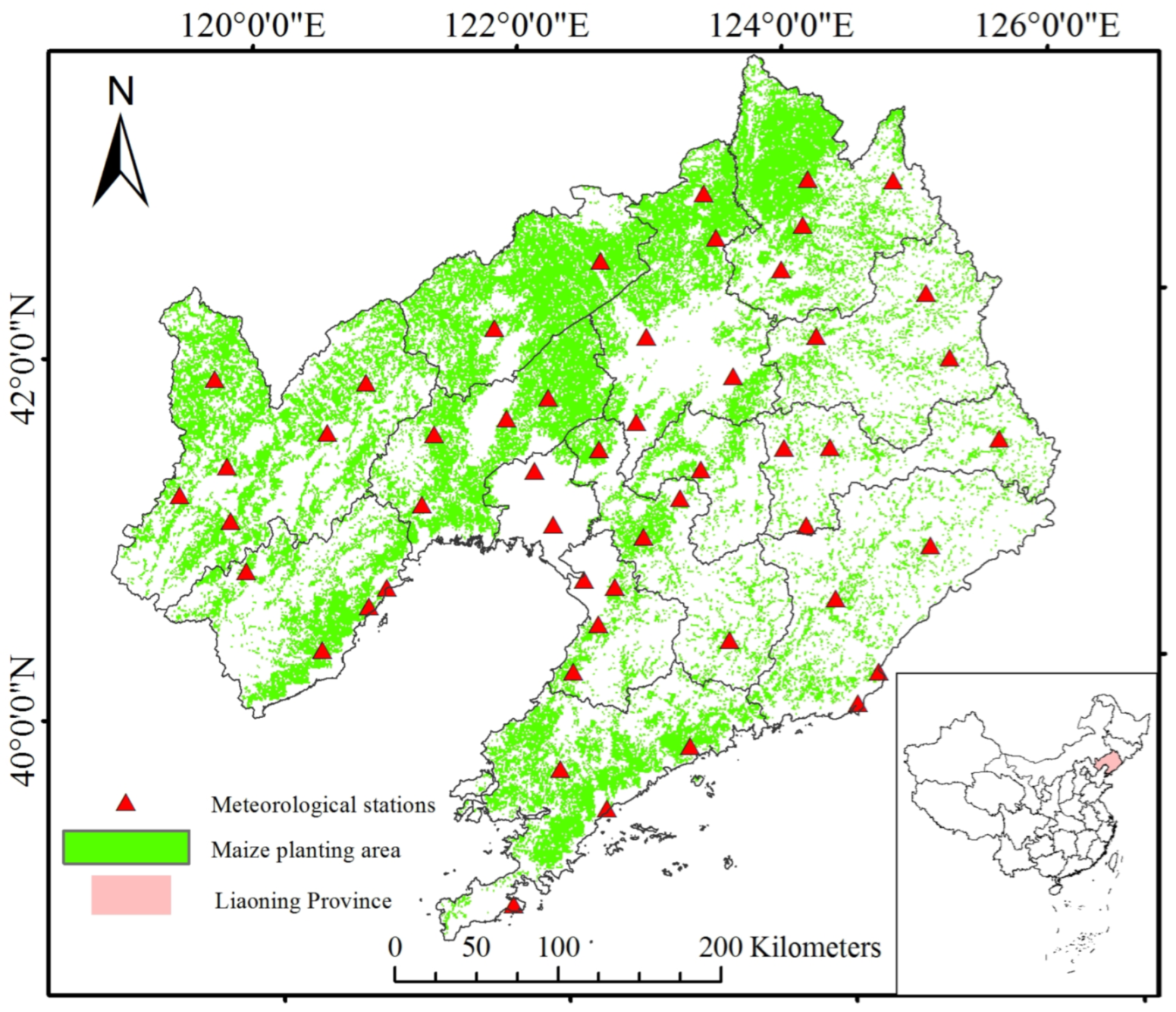

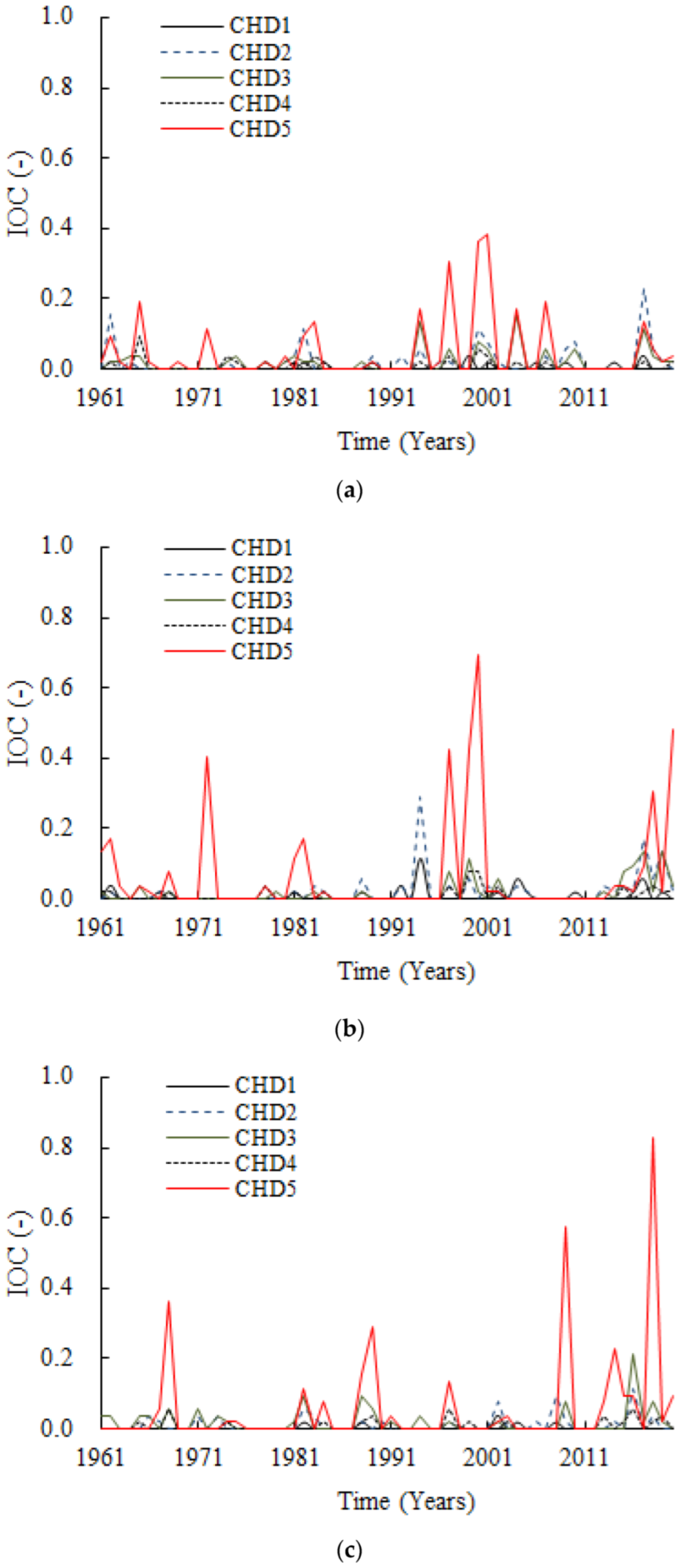


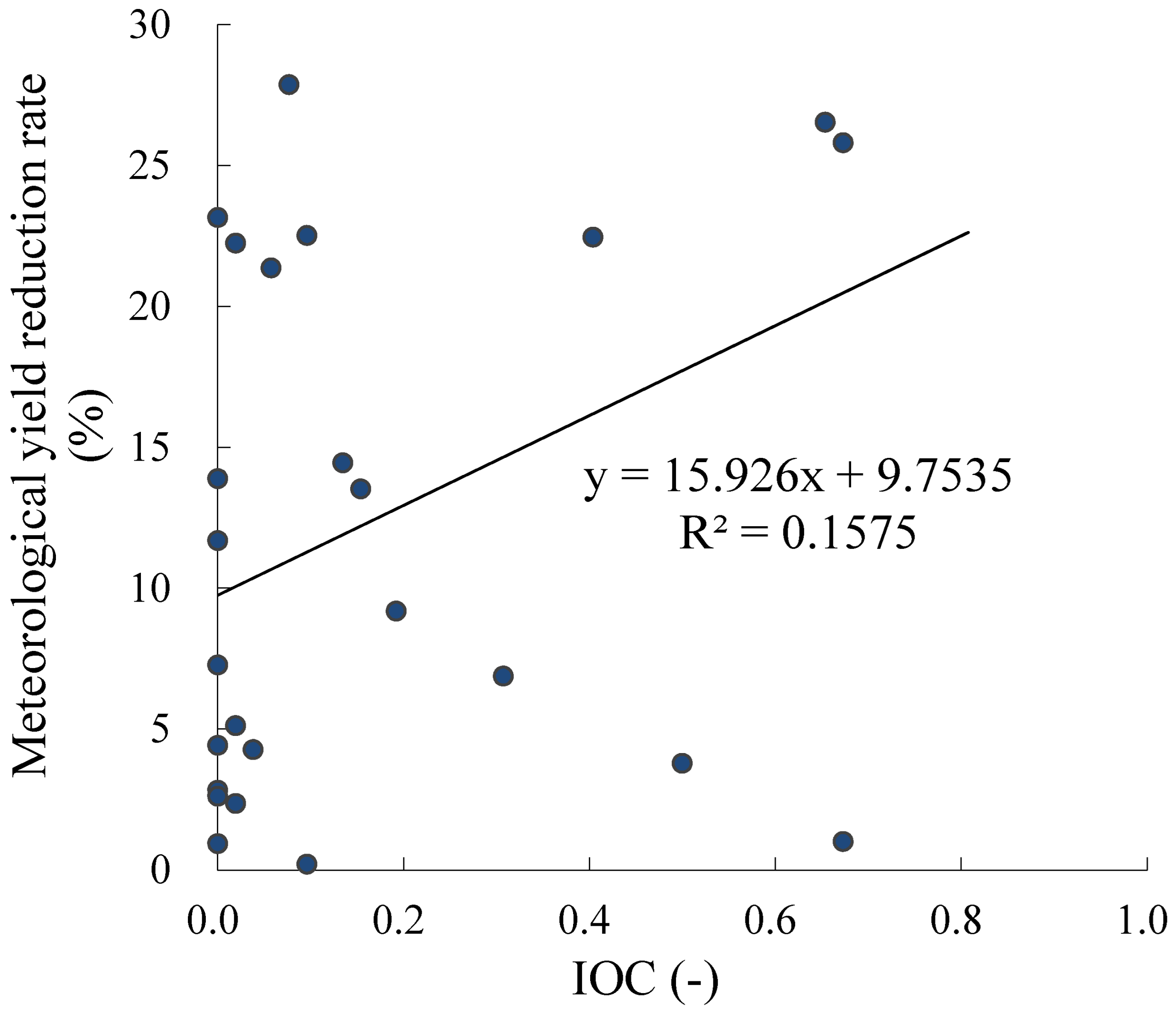

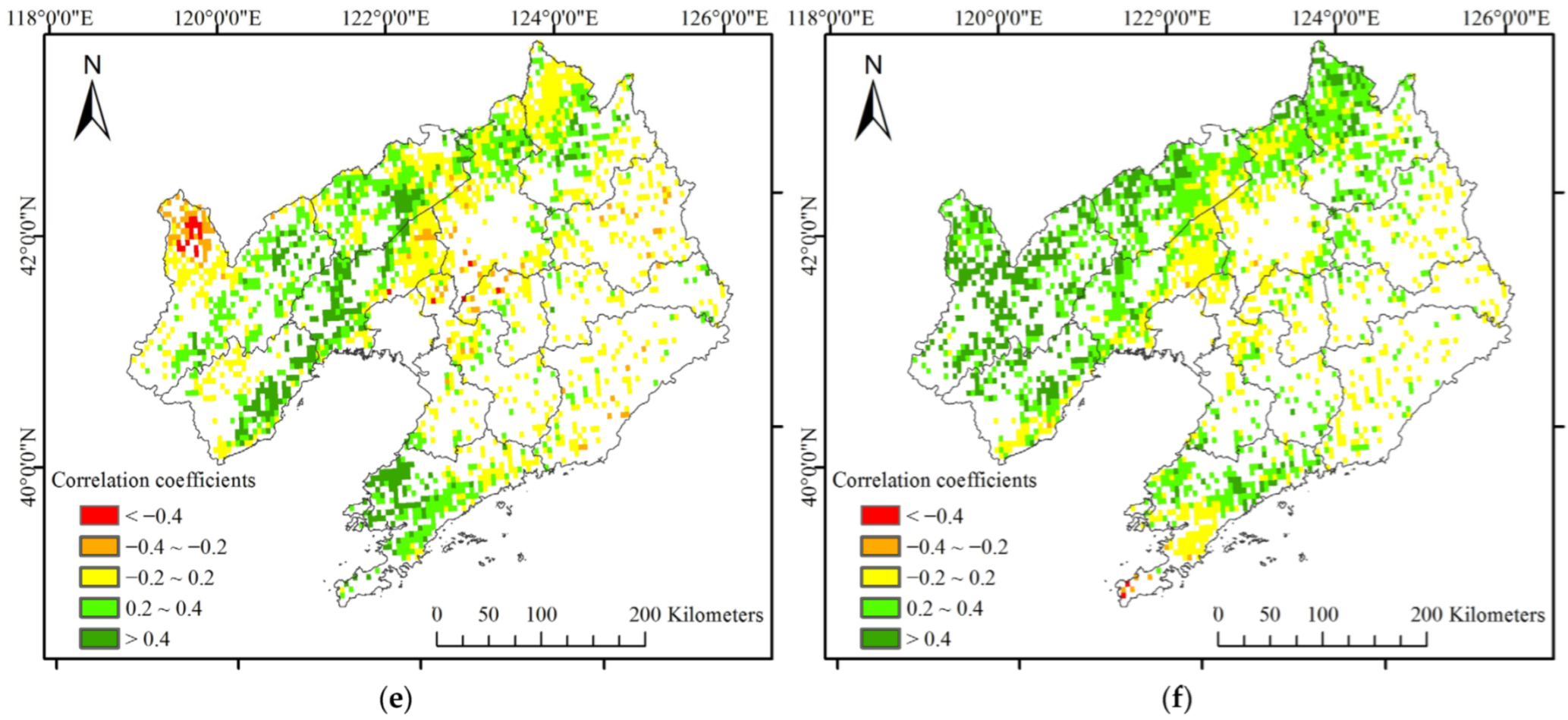


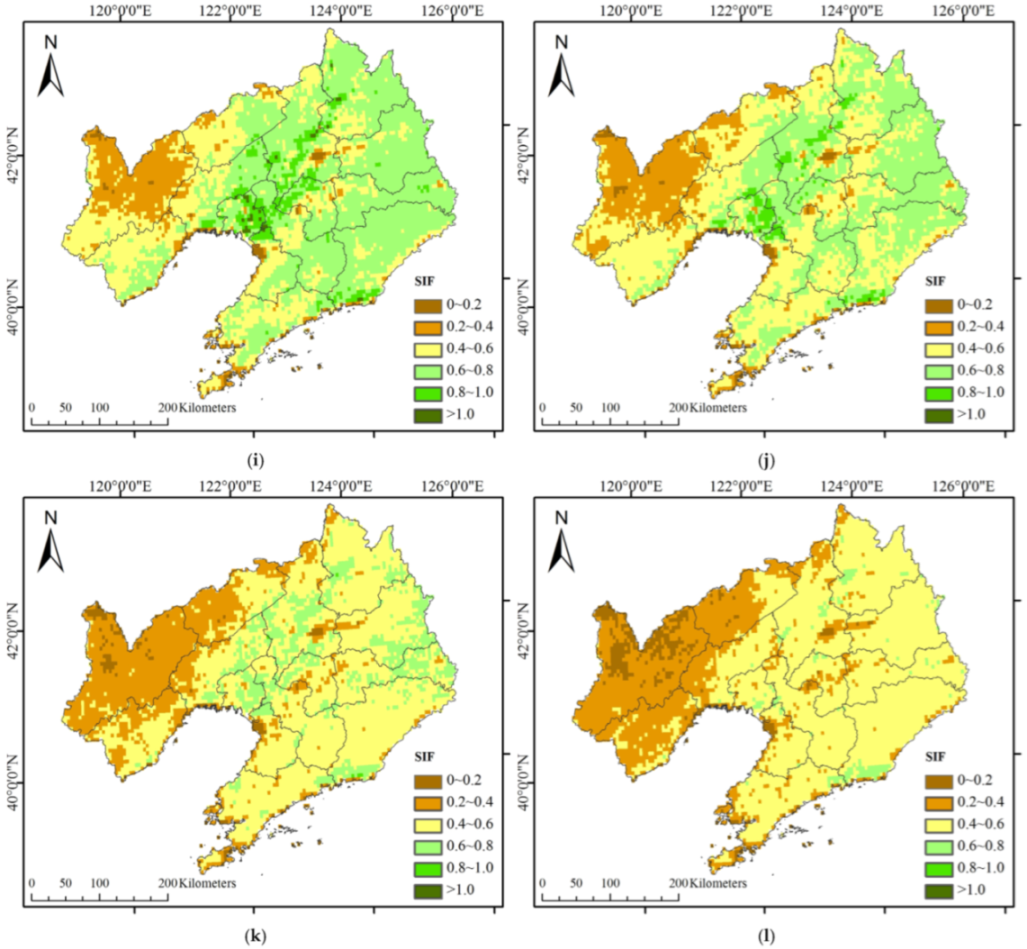




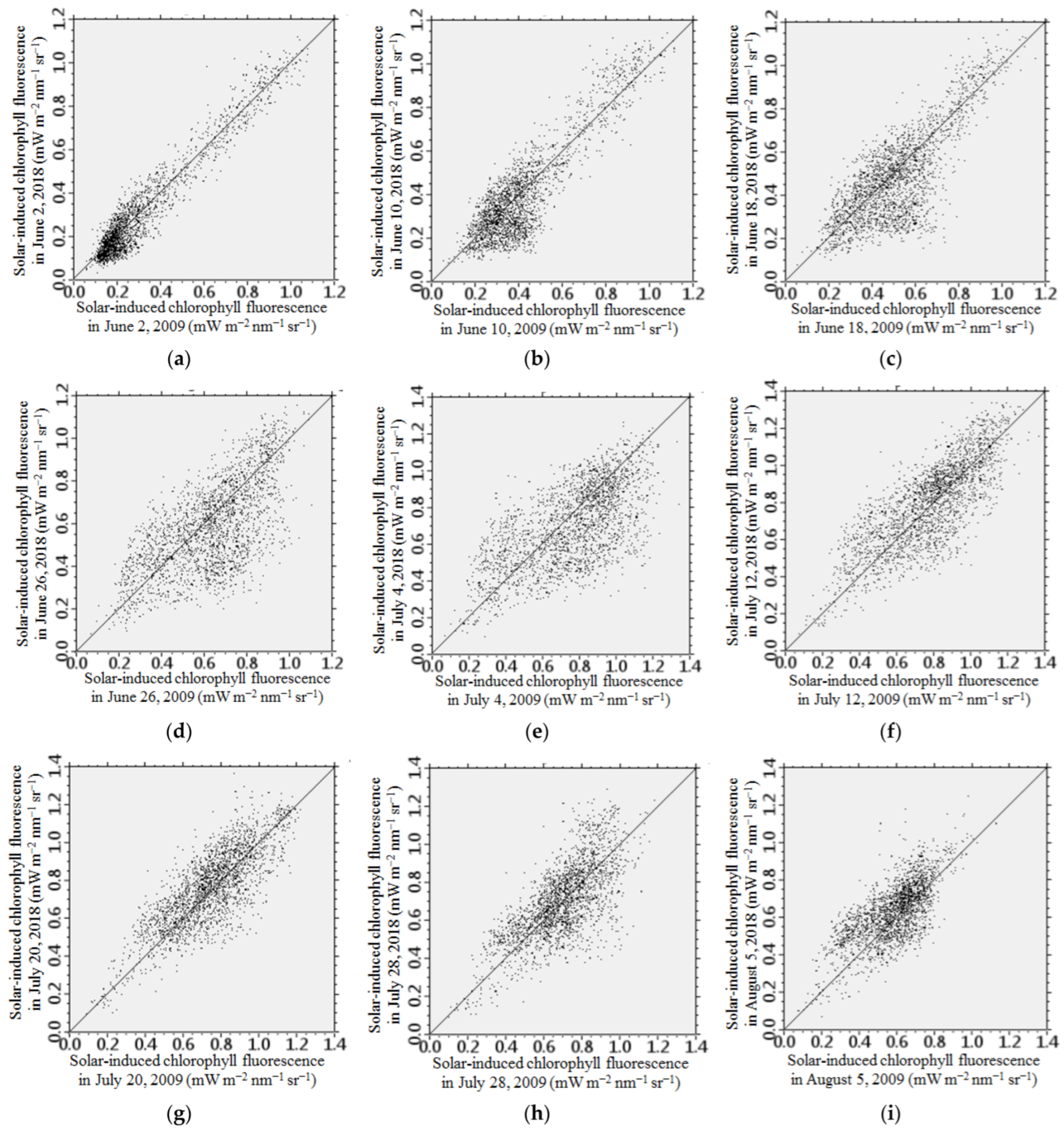
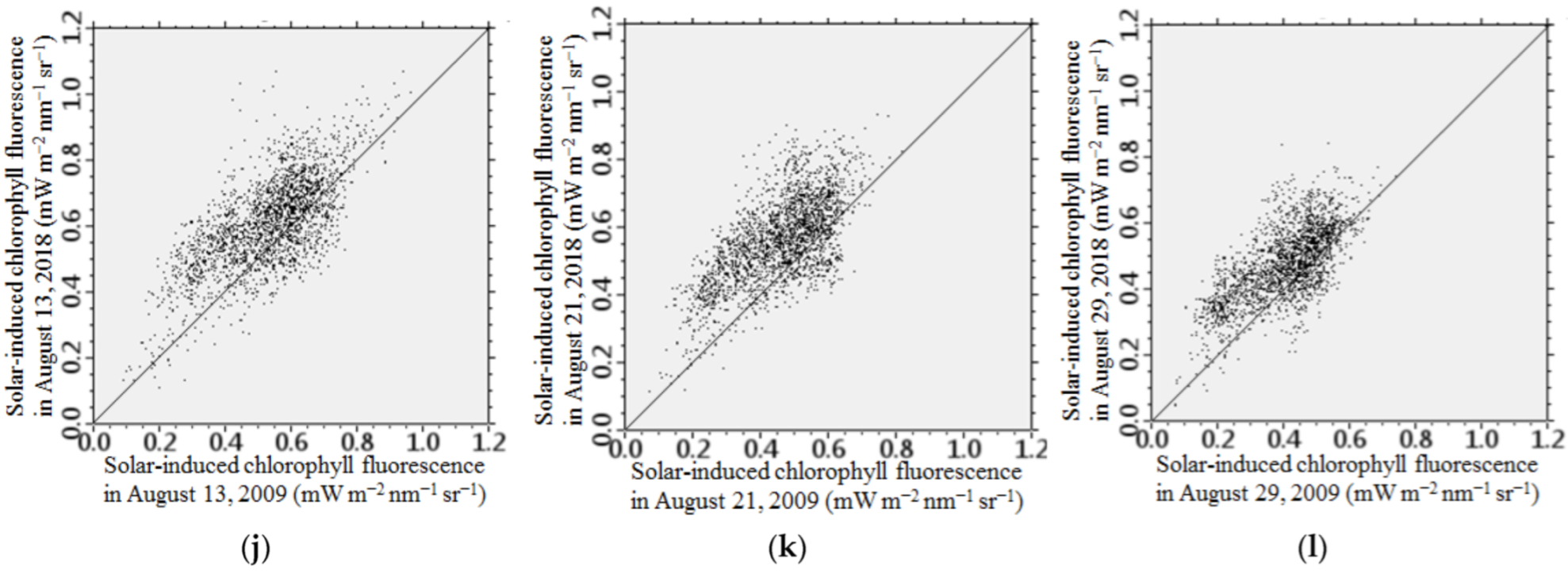
| Type | Large-Scale | Regional |
|---|---|---|
| June | 2000, 2001, 2017 | 1962, 1965, 1982, 1994, 1997, 2004, 2007 |
| July | 1997, 1999, 2000, 2020 | 1962, 1972, 1994, 2017, 2018, 2019 |
| August | 2009, 2018 | 1968, 1982, 1988, 1989, 1997, 2014, 2016 |
Disclaimer/Publisher’s Note: The statements, opinions and data contained in all publications are solely those of the individual author(s) and contributor(s) and not of MDPI and/or the editor(s). MDPI and/or the editor(s) disclaim responsibility for any injury to people or property resulting from any ideas, methods, instructions or products referred to in the content. |
© 2023 by the authors. Licensee MDPI, Basel, Switzerland. This article is an open access article distributed under the terms and conditions of the Creative Commons Attribution (CC BY) license (https://creativecommons.org/licenses/by/4.0/).
Share and Cite
Yu, W.; Ji, R.; Wu, J.; Feng, R.; Mi, N.; Chen, N. Combined Effects of Heat and Drought Stress on the Growth Process and Yield of Maize (Zea mays L.) in Liaoning Province, China. Atmosphere 2023, 14, 1397. https://doi.org/10.3390/atmos14091397
Yu W, Ji R, Wu J, Feng R, Mi N, Chen N. Combined Effects of Heat and Drought Stress on the Growth Process and Yield of Maize (Zea mays L.) in Liaoning Province, China. Atmosphere. 2023; 14(9):1397. https://doi.org/10.3390/atmos14091397
Chicago/Turabian StyleYu, Wenying, Ruipeng Ji, Jinwen Wu, Rui Feng, Na Mi, and Nina Chen. 2023. "Combined Effects of Heat and Drought Stress on the Growth Process and Yield of Maize (Zea mays L.) in Liaoning Province, China" Atmosphere 14, no. 9: 1397. https://doi.org/10.3390/atmos14091397
APA StyleYu, W., Ji, R., Wu, J., Feng, R., Mi, N., & Chen, N. (2023). Combined Effects of Heat and Drought Stress on the Growth Process and Yield of Maize (Zea mays L.) in Liaoning Province, China. Atmosphere, 14(9), 1397. https://doi.org/10.3390/atmos14091397







